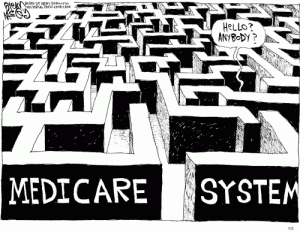By Jack Cumming
Trends in senior housing include increasing entry ages, higher acuities for care needs, and resistance to adaptive change. Belief in a coming demographic bonanza may be reassuring personally for executives and other industry notables, but the future is not necessarily that predictable. It may seem inexorable, but that’s belief, not reality.
CCRCs are increasingly health care facilities. In their heyday of popularity during the 1990s, they primarily promised carefree living through old age. Care services then were a “when necessary” standby benefit. Marketing tropes that used to sell a lifestyle now look for those “who are ready for that.” How’s that working? Senior care market parameters are shrinking while resistance to institutionalization is increasing.
Changing the Paradigm
What does the “that” in “ready for that” mean? It means prospects who need care and have no choice but to move in. Many prophecies for a bountiful senior living industry point to the baby boomers, believing that demand will outstrip supply when the boomers reach the stage at which they will have no choice. They will then be “ready for that.”
Just putting those words down on paper reveals the challenge. Of course, the boomers will change the paradigm. They’ve done that every step of their way through life, beginning with their origins in the post-World-War-II “return to normalcy.” That “normalcy” gave us suburban sprawl, “sundown” towns, and The Saturday Evening Post. That all changed during the 1960s, continuing into the 1970s and beyond.
Just as the boomers have changed other expectations, they are changing how they live their later years as well. If I were to speculate, I would imagine that a common pattern will be for this unique demographic cohort to stay put, bringing in assistance as needed and ending life living in intimate board and care facilities or in an extra room in their children’s home. That’s more appealing than institutional, large-staff facility life.
Changing Preferences
Of course, as one ages, the romance of a single-family home can grow stale when the toilet regularly backs up or there are unexplained leaks. That can make apartment dwellings attractive, but since many boomers own their single-family homes, they want ownership in apartment dwellings as well. The ownership reversal concept of giving up ownership to pay an entrance fee for a living unit that you don’t own, on its face, if fully understood, does not seem attractive.
What, then, would the smart money do? Would it continue to pursue the prevailing mythology that not-for-profit institutions are preferable to other forms of housing for old people? That doesn’t seem plausible, but it might work. Some industry associations and advisers are trying to make it continue to work for them. Still, to this observer, that seems like a very brittle business model on which to rely.
Human Connection
Then, there are those pesky social determinants of health. On its face, congregate living and dining with neighbors seems like an ideal path to avert a lonely decline into the hereafter. In truth, that works for the social set, but it can be its reverse for those who are shy, frail, or age challenged. Congregate living works better in the general housing market than in housing dedicated to aging. Dining with a failing oldster can be a real downer.
Today’s senior housing is beginning to feel stale. The industry has responded semantically by changing descriptive words. “Facility” is a no-no, but avoiding the word is meaningless if the “community” has all the trappings of a facility. Similarly, changing from “continuing care” to “life plan” is meaningless if the trend is toward more care and less life. At least a board and care run by an RN and a handy spouse feels like a family home.
Adapting to Change
If a provider chooses to buck the trend by moving beyond a focus on people who are “ready for that,” what’s to be done? Obviously, the big opportunity, the big need, and the big money are with those who aren’t yet ready for that. Many aging prospects want homes from which they can come and go without care. Many are moving to multifamily homes, whether they are ownership — cooperative or condominium — or rental models.
That presents a huge opportunity for meeting needs and building a meaningful business. Senior housing is staff-heavy. That impacts value and there is opportunity in that. Imagine multifamily housing with a food and beverage clubroom, a business center, and a reading room, in addition to the standard fitness center. That is already an option for young singles. Click here for an example. Why not the same for people of all ages? That’s the reality for those few willing to live at sea. It just makes sense.
Creative Imagination
This is where perception meets imagination. Our culture is evolving. The aging models that fit the World War II veterans are gone. Change is also impacting society in general. The traditional separation of work, home, and recreation is converging into a new model in which many work from home, and others consider work to be their recreation.
That requires new thinking. The opportunity is to meet these new needs by changing living offerings to match the new culture. It’s bucking the trend to assert that a “public benefit” nonprofit corporation is not the best business model for capital-intensive, market-priced senior housing. A cooperative — “mutual benefit” or standard — can preserve the beneficial concept. Other approaches reduce resident financial risk.
The times call for more than fantasizing that aging baby boomers are going to create an effortless demand wave. No one wants to move into housing that labels them as old, frail, and failing. Setting age requirements trumpet that loud and clear. Calling it “senior living” reinforces that finality.
It’s time to drop the “senior” from senior housing. It’s time to get out of senior housing financing and into housing financing. It’s time to get out of senior housing accounting and into general business accounting. It’s time to convert senior housing to shared housing. It’s time to embrace those of a certain age as being no different from all people. #InThisTogether









Very well written, Jack.
Indeed, well written. No option is satisfactory for everyone. As a baby boomer prospect for senior housing, for now I have have more opportunities for socializing than I can handle. So that aspect is not especially attractive for me. The model described by the author doesn’t talk about the care component, and that’s what my concern is. The rest is a lot more easily manageable. Finding quality, appropriate, trustworthy and reliable care when needed and managing it is what I see as a major issue that is not addressed. Everybody doesn’t just fall asleep one evening and never wake up. This period between our healthy and active selves and the time to say good bye cannot be just skipped and ignored, as many try. If I would move to the type of community described by Jack, what would I do when I start needing care? This is the missing piece of most proposed approaches. Who wants to go to a nursing home? The current main options for some level of care are the CCRCs and senior housing communities that offer AL & MC, but the quality of care they offer is many times questionable, as discussed on this website and many other places. It is hard to trust them as their contracts do not offer any assurances that the needed QUALITY care will be there when time comes. CCRC residents in particular are hostages usually with no exit options. Not that a resident of a rental community would find it easy to just pickup and leave at a time of their life when they need most help. The book version of the “continuing care” communities was great. The implementation is lacking, particularly with nursing care being dropped in many places and the Type A contracts disappearing. There is no country for old people, regardless what the senior housing industry tells us. The best of what exists is wishful, maybe visionary thinking. Should you disagree, please point me to the widely available senior housing option that includes quality, reliable and trustworthy care, backed up by a contract that ensures that one will get for their lifetime what they are paying for.
This is exactly what we are developing, on resort-lifestyle properties not limited to 55+, to include active single ‘high functioning’ adults & older or ’empty nest’ couples, where all can age in place with resort lifestyle amenities, either on true full resort properties or A.L. properties with full spectrum high quality services, via private entities and designated funds. Thanks for describing objectively where the market is going, & its subsequent demands we’ve been watching & preparing for under unique branding in multiple scaling models for both specialized care & highly desired equally permanent environments where wellness & care needs evolve as residents do, so the chapters of their lives can be chronicled as they wish, even with support to get all chapters recorded and even published, as but one of many hobby or entrepreneurial activities made accessible, amongst other ‘happiness factors’.
My thinking should have been clearer. Of course, a specialized care provider can deliver care to aging residents in a naturally aging multi-family context just as integrated CCRCs now deliver care. By unbundling the care portion, care providers can differentiate themselves by offering higher quality care services. Some CCRCs offer outstanding care; others, not so much.
It would be helpful to explore and explain how to assess and get an objective evaluation of the quality of care services in senior communities before joining them. Are there any standards defining them and enforced licensing requirements supporting them in any states? How does one know which CCRCs offer outstanding care vs. those which do not? Neither residents nor marketing/sales staff will share reality.